Articles
The Dictionary of Musical Symbols
Music has its own language. If you aren’t fluent, you might be wondering where to start. As a beginner musician, you don’t necessarily need to know every hemiola and glissando.
But, you will come across some common symbols again and again. Understanding them will make your life easier. Here is a concise breakdown of the musical symbols you should get to know.
Staff, Clefs, and Time Signatures
The staff is the basis of all music composition. We can use it as the foundation to discuss what else you will see within a piece of written music.
| Symbol | Definition |
 |
Staff / Stave: The staff are the lines where music and symbols are placed. There are five lines and four spaces, and they serve to orientate the notes. |
 |
Bar / Measure: The staff is broken into measures, which are separated by these bars. A measure is also called a ‘bar’. |
 |
Bold doublebar line: This doublebar represents the end of a movement or a piece. |
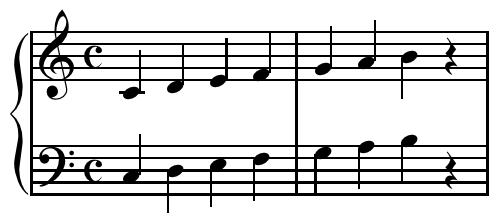 |
Bracket: The bracket connects lines of music that play in tandem. For example, you’ll see this split in piano music, where the top line will be the right hand playing in G-Clef and the bottom will be the left hand in F-Clef. |
 |
G / Treble Clef: Where the symbol spirals, this denotes the G-pitch above Middle-C. This clef is used in most modern vocal music. In piano music, it is usually played by the right hand. Guitar music is also generally written in Treble Clef. |
 |
F/ Bass Clef: The line between the two dots denotes the F-note below Middle-C. This clef represents bass and baritone voices in choral music. |
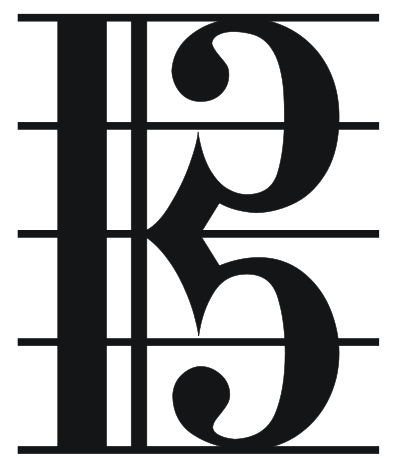 |
C/ Alto / Viola Clef: he Where the two curved lines come together to grip the line, that line denotes Middle-C. This clef is used for viola music. When centered on the fourth line of the staff, it can be used for bassoon, trombone or cello music. |
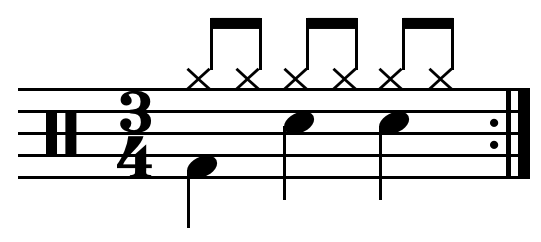 |
Time Signature: The numbers at the beginning of a piece that indicate the rhythm of the music. The bottom number (in this case 4) represents the note value of one beat (in this case, a quarter note or crotchet). The top number (in this case 3) represents how many of these notes appear in each measure. This time signature is known as ‘three-quarter time’. |
 |
Common Time: The most common time signature is 4/4 time, or ‘common time.’ It can also be represented as a C. |
 |
Cut Time: Another common time signature – 2/2 time or ‘cut time.’ It is also represented as a C with a vertical line through it. |
Notes
A note is placed in a certain location on the staff to indicate which note it is. However, you can also tell how long to play that note, based on the way it looks.
| Note | Definition |
 |
Whole Note / Semibreve: This note represents one entire measure. For example, four beats in 4/4 time signature. Other notes are usually fractions of this note. It never has a stem. |
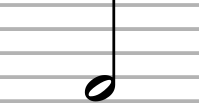 (image licensed under CC-SA 3) (image licensed under CC-SA 3) |
Half Note / Minim: The note represents one half of the whole note. It’s two beats in 4/4 time, or half of the measure. This note can be depicted with the stem pointing downward on the left side. |
 (image licensed under CC-SA 3) (image licensed under CC-SA 3) |
Quarter Note / Crotchet: One quarter of a whole note. One beat in 4/4 time. Musicians may refer to this as “one beat”, but it’s only one beat when the time signature is 4/4. This note can be depicted with the stem pointing downward on the left side. |
 |
Eighth Note / Quaver: Half of the value of a quarter note. Notes of this value and shorter are beamed together when there are two or more in a row. This note can also be depicted with the stem pointing downward on the left side. |
 (image licensed under CC-SA 3) (image licensed under CC-SA 3) |
Sixteenth Note / Semiquaver: Half of the value of an eighth note. Drawn with the stem to the right of the head when below the middle line of the staff. When above the middle line, depicted with the stem on the left side of the note, pointing down. |
 |
Beamed Notes: These notes connect eighth notes and notes of shorter value. They reflect rhythmic groupings of notes. |
 |
Dotted Notes: When you see a dot next to a note, increase the duration of that note by half of its original value. For example, a dotted quarter note becomes a quarter note plus an eighth note. |
 |
Chord: A chord is written whenever you are playing more than one note simultaneously. A chord can contain any number of notes. |
Rests
Silence is just as important as sound in music. Rests indicate the amount of time you will pause when you’re going through a composition.
| Rest | Definition |
 |
Whole Rest: This rest represents one entire measure. It’s four beats in 4/4 time signature, and corresponds to the whole note. |
 |
Half Rest: This symbol indicates you will rest for the amount of time equal to half of the whole note. It looks similar to the whole note, but notice that it rests above the line, as opposed to below it, as the whole rest does. |
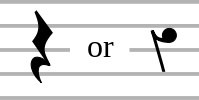 (image licensed under CC-SA 3) (image licensed under CC-SA 3) |
Quarter Rest: A rest that’s equivalent to the crotchet, or quarter note. |
 |
Eighth Rest: A rest that’s equivalent to an eighth or note or quaver. For notes of this length and shorter, the rest has the same number of branches as the note has flags. |
 |
Sixteenth Rest: A rest that’s equal to a sixteenth note. Note how it has two branches, just like the note itself has two flags. |
Accidentals
Accidentals indicate a modification in pitch. If you see an accidental in a measure, it stays applicable within that measure, unless otherwise indicated.
| Accidental | Definition |
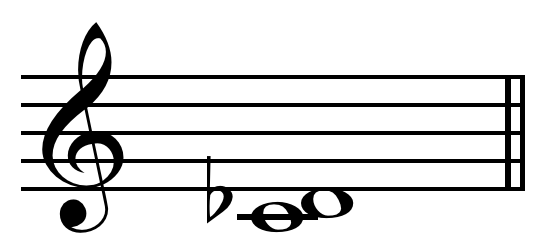 |
Flat: A flat lowers the pitch of the note by one halfstep or semitone. |
 (image licensed under CC-SA 3) (image licensed under CC-SA 3) |
Sharp: A sharp makes the pitch of the note higher by one halfstep or semitone. |
 (image licensed under CC-SA 3) (image licensed under CC-SA 3) |
Natural: A natural cancels out a previous accidental, modifying the pitch back to its original note. |
 (image licensed under CC-SA 3) (image licensed under CC-SA 3) |
Double Flat: A double flat lowers a note’s pitch by two semitones, or one whole step. |
 (image licensed under CC-SA 3) (image licensed under CC-SA 3) |
Double Sharp: A double sharp raises a note’s pitch by two semitones, or one whole step. |
Dynamics
Dynamics depict volume or emotion and intensity of the composition or section of the composition.
| Dynamic | Definition |
 |
Pianissimo: Very soft and quiet. |
 |
Piano: Soft and quiet. |
 |
Mezzo piano: Moderately soft and quiet. |
 |
Mezzo forte: Moderately loud. |
 |
Forte: Loud and strong. |
 |
Fortissimo: Very loud and strong. |
 |
Sforzando: Abrupt, accented, forceful. |
 |
Crescendo: A gradual increase in volume, over the span of the notes where it is written. |
 |
Decrescendo: A gradual decrease in volume, over the span of the notes where it is written. |
For more information, check out the Dolmetsch chart of musical symbols, which is considered to be one of the online authorities on musical symbols. Another option is the Oxford Music Online, which has long been an authority used by musicians across the world. It explores musical composition, history, theory and composers in more than 12,500 entries.
Also, to put this new knowledge into practice, check out Sheet Music Scanner. It can read sheet music and play to back to you – it’s as simple as uploading a PDF or taking a picture with your phone.